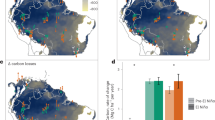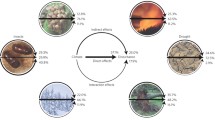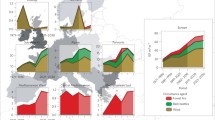Abstract
Forests are a major terrestrial carbon sink, but the increasing frequency and intensity of climate-driven disturbances such as droughts, fires and biotic agent outbreaks is threatening carbon uptake and sequestration. Determining how climate-driven disturbances may alter the capacity of forest carbon sinks in a changing climate is crucial. Here we show that the sensitivity of gross primary productivity to subsequent water stress increased significantly after initial drought and fire disturbances in the conterminous United States. Insect outbreak events, however, did not have significant impacts. Hot and dry environments generally exhibited increased sensitivity. Estimated ecosystem productivity and terrestrial carbon uptake decreased markedly with future warming scenarios due to the increased sensitivity to water stress. Our results highlight that intensifying disturbance regimes are likely to further impact forest sustainability and carbon sequestration, increasing potential risks to future terrestrial carbon sinks and climate change mitigation.




Similar content being viewed by others
Data availability
The NTSG Landsat GPP data were obtained from Google Earth Engine: https://developers.google.com/earth-engine/datasets/catalog. The GLASS GPP data were obtained from http://www.glass.umd.edu/Download.html. The EC-LUE GPP data were obtained from https://doi.org/10.6084/m9.figshare.8942336.v3. The NIRv GPP data were downloaded from https://doi.org/10.6084/m9.figshare.12981977.v2. The FLUXNET2015 GPP dataset is available at https://fluxnet.org/data/fluxnet2015-dataset/. The historical climatic data (for example, precipitation) and PDSI data were obtained from TerraClimate (https://www.climatologylab.org/terraclimate.html). The climatic data under +2 °C warming scenario were also obtained from TerraClimate (https://www.climatologylab.org/terraclimate.html). The MTBS maps of fire severity are available at https://www.mtbs.gov/direct-download. The land-cover maps were obtained from Earthdata (https://lpdaac.usgs.gov/products/mcd12q1v006/). The mean annual rates of mortality were from ref. 11, and no new mortality data were produced. The US boundary was from DATA.GOV (https://data.gov/). The data produced in this study are available via Figshare (https://doi.org/10.6084/m9.figshare.23730507)48.
Code availability
All analysis was done in the open-source software R. The code is available via Figshare (https://doi.org/10.6084/m9.figshare.23730507)48.
References
Friedlingstein, P. et al. Global carbon budget 2022. Earth Syst. Sci. Data 14, 4811–4900 (2022).
Wear, D. N. & Coulston, J. W. From sink to source: regional variation in US forest carbon futures. Sci. Rep. 5, 16518 (2015).
Griscom, B. W. et al. Natural climate solutions. Proc. Natl Acad. Sci. USA 114, 11645–11650 (2017).
Fargione, J. E. et al. Natural climate solutions for the United States. Sci. Adv. 4, eaat1869 (2018).
Seidl, R. et al. Forest disturbances under climate change. Nat. Clim. Change 7, 395–402 (2017).
McDowell, N. G. & Allen, C. D. Darcy’s law predicts widespread forest mortality under climate warming. Nat. Clim. Change 5, 669–672 (2015).
Williams, C. A., Gu, H., MacLean, R., Masek, J. G. & Collatz, G. J. Disturbance and the carbon balance of US forests: a quantitative review of impacts from harvests, fires, insects, and droughts. Glob. Planet. Change 143, 66–80 (2016).
Hemes, K. S., Norlen, C. A., Wang, J. A., Goulden, M. L. & Field, C. B. The magnitude and pace of photosynthetic recovery after wildfire in California ecosystems. Proc. Natl Acad. Sci. USA 120, e2201954120 (2023).
Anderegg, W. R. L., Trugman, A. T., Badgley, G., Konings, A. G. & Shaw, J. Divergent forest sensitivity to repeated extreme droughts. Nat. Clim. Change 10, 1091–1095 (2020).
Anderegg, W. R. L. et al. Climate-driven risks to the climate mitigation potential of forests. Science 368, eaaz7005 (2020).
Anderegg, W. R. L. et al. Future climate risks from stress, insects and fire across US forests. Ecol. Lett. 25, 1510–1520 (2022).
Dai, A. Drought under global warming: a review. Wiley Interdiscip. Rev. Clim. Change 2, 45–65 (2011).
Cook, B. I., Ault, T. R. & Smerdon, J. E. Unprecedented 21st century drought risk in the American Southwest and Central Plains. Sci. Adv. 1, e1400082 (2015).
Ciais, P. et al. Europe-wide reduction in primary productivity caused by the heat and drought in 2003. Nature 437, 529–533 (2005).
Schwalm, C. R. et al. Global patterns of drought recovery. Nature 548, 202–205 (2017).
Keen, R. M. et al. Changes in tree drought sensitivity provided early warning signals to the California drought and forest mortality event. Glob. Change Biol. 28, 1119–1132 (2022).
Fu, Z. et al. Sensitivity of gross primary productivity to climatic drivers during the summer drought of 2018 in Europe. Phil. Trans. R. Soc. B 375, 20190747 (2020).
Phillips, R. P. et al. A belowground perspective on the drought sensitivity of forests: towards improved understanding and simulation. For. Ecol. Manage. 380, 309–320 (2016).
McDowell, N. et al. Mechanisms of plant survival and mortality during drought: why do some plants survive while others succumb to drought? N. Phytol. 178, 719–739 (2008).
Cartwright, J. M., Littlefield, C. E., Michalak, J. L., Lawler, J. J. & Dobrowski, S. Z. Topographic, soil, and climate drivers of drought sensitivity in forests and shrublands of the Pacific Northwest, USA. Sci. Rep. 10, 18486 (2020).
Rosner, S. et al. Wood density as a screening trait for drought sensitivity in Norway spruce. Can. J. For. Res. 44, 154–161 (2014).
Mausolf, K. et al. Higher drought sensitivity of radial growth of European beech in managed than in unmanaged forests. Sci. Total Environ. 642, 1201–1208 (2018).
Lebourgeois, F., Gomez, N., Pinto, P. & Mérian, P. Mixed stands reduce Abies alba tree-ring sensitivity to summer drought in the Vosges mountains, western Europe. For. Ecol. Manage. 303, 61–71 (2013).
Linares, J. C., Taïqui, L., Sangüesa-Barreda, G., Seco, J. I. & Camarero, J. J. Age-related drought sensitivity of Atlas cedar (Cedrus atlantica) in the Moroccan Middle Atlas forests. Dendrochronologia 31, 88–96 (2013).
Palmer, W. C. Meteorological Drought (US Department of Commerce Weather Bureau, 1965).
Beguería, S., Vicente-Serrano, S. M., Reig, F. & Latorre, B. Standardized precipitation evapotranspiration index (SPEI) revisited: parameter fitting, evapotranspiration models, tools, datasets and drought monitoring. Int. J. Climatol. 34, 3001–3023 (2014).
Trugman, A. T., Medvigy, D., Anderegg, W. R. L. & Pacala, S. W. Differential declines in Alaskan boreal forest vitality related to climate and competition. Glob. Change Biol. 24, 1097–1107 (2018).
Anderegg, W. R. L. et al. Pervasive drought legacies in forest ecosystems and their implications for carbon cycle models. Science 349, 528–532 (2015).
Tumber-Dávila, S. J., Schenk, H. J., Du, E. & Jackson, R. B. Plant sizes and shapes above and belowground and their interactions with climate. N. Phytol. 235, 1032–1056 (2022).
Voelker, S. L. et al. Fire deficits have increased drought sensitivity in dry conifer forests: fire frequency and tree-ring carbon isotope evidence from Central Oregon. Glob. Change Biol. 25, 1247–1262 (2019).
Sheil, D. Disturbance and distributions: avoiding exclusion in a warming world. Ecol. Soc. 21, 445–466 (2016).
Trugman, A. T., Anderegg, L. D. L., Shaw, J. D. & Anderegg, W. R. L. Trait velocities reveal that mortality has driven widespread coordinated shifts in forest hydraulic trait composition. Proc. Natl Acad. Sci. USA 117, 8532–8538 (2020).
Adhikari, A. et al. Management and climate variability effects on understory productivity of forest and savanna ecosystems in Oklahoma, USA. Ecosphere 12, e03576 (2021).
Anderegg, W. R. L. et al. A climate risk analysis of Earth’s forests in the 21st century. Science 377, 1099–1103 (2022).
Robinson, N. P. et al. Terrestrial primary production for the conterminous United States derived from Landsat 30 m and MODIS 250 m. Remote Sens. Ecol. Conserv. 4, 264–280 (2018).
Liang, S. et al. The Global Land Surface Satellite (GLASS) product suite. Bull. Am. Meteorol. Soc. 102, E323–E337 (2021).
Zheng, Y. et al. Improved estimate of global gross primary production for reproducing its long-term variation, 1982–2017. Earth Syst. Sci. Data 12, 2725–2746 (2020).
Wang, S., Zhang, Y., Ju, W., Qiu, B. & Zhang, Z. Tracking the seasonal and inter-annual variations of global gross primary production during last four decades using satellite near-infrared reflectance data. Sci. Total Environ. 755, 142569 (2020).
Wells, N., Goddard, S. & Hayes, M. J. A self-calibrating Palmer Drought Severity Index. J. Clim. 17, 2335–2351 (2004).
Abatzoglou, J. T., Dobrowski, S. Z., Parks, S. A. & Hegewisch, K. C. TerraClimate, a high-resolution global dataset of monthly climate and climatic water balance from 1958–2015. Sci. Data 5, 170191 (2018).
van der Schrier, G., Barichivich, J., Briffa, K. R. & Jones, P. D. A scPDSI-based global data set of dry and wet spells for 1901–2009. J. Geophys. Res. Atmos. 118, 4025–4048 (2013).
Aitken, A. C. On least squares and linear combination of observations. Proc. R. Soc. Edinb. 55, 42–48 (1936).
Breiman, L. Random Forests. Mach. Learn. 45, 5–32 (2001).
Cao, S. et al. Spatiotemporally consistent global dataset of the GIMMS Leaf Area Index (GIMMS LAI4g) from 1982 to 2020. Earth Syst. Sci. Data. 15, 4877–4899 (2023).
Cheng, W. et al. Global monthly gridded atmospheric carbon dioxide concentrations under the historical and future scenarios. Sci. Data 9, 83 (2022).
Qin, Y. et al. Agricultural risks from changing snowmelt. Nat. Clim. Change 10, 459–465 (2020).
Stocker, B. D. et al. Drought impacts on terrestrial primary production underestimated by satellite monitoring. Nat. Geosci. 12, 264–270 (2019).
Liu, M. et al. Forest sensitivity change in response to disturbances. Figshare https://doi.org/10.6084/m9.figshare.23730507 (2023).
Acknowledgements
The study was supported by the Wilkes Center at the University of Utah, and thanks to the Anderegg lab. J.P. was supported by the TED2021-132627B-I00 grant, funded by MCIN and the European Union NextGeneration EU/PRTR, and the CIVP20A6621 grant funded by the Fundación Ramón Areces. A.T.T. acknowledges funding from National Science Foundation grants 2003205, 2017949 and 2216855, the University of California Laboratory Fees Research Program award no. LFR-20-652467 and the Gordon and Betty Moore Foundation grant GBMF11974. W.R.L.A. acknowledges support from the David and Lucille Packard Foundation and US National Science Foundation grants 1802880, 2003017 and 2044937 as well as the Alan T. Waterman award IOS-2325700.
Author information
Authors and Affiliations
Contributions
M.L. and W.R.L.A. conceptualized and designed the study with input from all co-authors. M.L. performed the analysis. M.L. wrote the initial draft and A.T.T., J.P. and W.R.L.A. discussed the design, analyses and results and provided extensive and valuable comments and revisions.
Corresponding author
Ethics declarations
Competing interests
The authors declare no competing interests.
Peer review
Peer review information
Nature Climate Change thanks Steven Running, Dominik Thom and the other, anonymous, reviewer(s) for their contribution to the peer review of this work.
Additional information
Publisher’s note Springer Nature remains neutral with regard to jurisdictional claims in published maps and institutional affiliations.
Extended data
Extended Data Fig. 1 The drought sensitivity increased significantly after severe droughts and fires when using SPEI to represent water stress.
(a–c) The change in sensitivity across CONUS after severe (a) droughts, (b) fires, and (c) insect outbreaks. The resolution of the distribution maps for fires and insect outbreaks was aggregated to 20 km for visual display. (d–f) The change in sensitivity among different land-cover types after severe (d) droughts (left to right, N=2668, 490, 5521, 1450, 8720), (e) fires (N=1944, 178, 258, 601, 6068), and (f) insect outbreaks (N=7320, 111, 548, 157, 3904). The error bars are standard errors. Asterisks indicate significance at the 0.05 level (two-sided) based on the GLS model. Multiple comparisons are not applicable. Definitions of disturbances for a pixel: droughts, SPEI < −1.2 (PDSI < ─3); fires, the proportion of burned area > 10%; insect outbreaks, insect caused mortality > 0.03%.
Extended Data Fig. 2 The best model for each pixel across CONUS.
a There are three models employed: linear (blue), quadratic (yellow), and logistic (red) models. The best model is defined as the one with the minimum Akaike Information Criterion (AIC). The linear model is the best for 69% of pixels across CONUS. b-c The (b) correlation between GPP anomaly and PDSI and (c) the corresponding significance (p < 0.05, two-sided t test). 60% of the available pixels present significant correlations between GPP anomaly and PDSI. d-f The change in sensitivity (Δk) for severe (d) droughts, (e) fires, and (f) insect outbreaks using the significant pixels in panel c. The results are comparable to those using all available pixels shown in Fig. 1.
Extended Data Fig. 3 The intercept of the GPP–PDSI model decreased significantly after severe disturbances.
(a–c) The changes in the intercept (Δb) across CONUS after severe (a) droughts, (b) fires, and (c) insect outbreaks. The resolution of the distribution maps for fires and insect outbreaks was aggregated to 20 km for visual display. Asterisks indicate significance at the 0.05 level (two-sided) based on the GLS model.
Extended Data Fig. 4 Land-cover map from the MCD12Q1 Type 5 classification in 2001.
ENF, evergreen needleleaf forest; EBF, evergreen broadleaf forest; and DBF, deciduous broadleaf forest.
Extended Data Fig. 5 Changes in drought sensitivity in undisturbed regions.
(a) The distribution of undisturbed regions in 1982–2018. (b) The trend of sensitivity (k) in undisturbed regions, where the trend was derived using an eight-year moving window, with k calculated for each window. The trend of sensitivity (Trend of k) is the slope of sensitivity vs year. (c) The mean trend of sensitivity for the land-cover types (left to right, N=258, 99, 2344, 228, 980), where the asterisks indicate significance (p = 0.002 and 0.003, respectively, two-sided) based on the GLS model. The error bars are standard errors. Multiple comparisons are not applicable. (d) The distribution of the trend of sensitivity (Trend of k) in climate space (mean annual temperature (MAT) vs mean annual precipitation (MAP)).
Extended Data Fig. 6 Correlation of the observed change in sensitivity and the Random Forest model estimated change in sensitivity.
(a–c) The scatterplots for severe (a) droughts, (b) fires, and (c) insect outbreaks. The red lines are the y = x lines, and orange color indicates high point density. The R2, slope, and p values (two-sided t test) are from linear regression: observed vs preidcted Δk. Multiple comparisons are not applicable.
Extended Data Fig. 7 Recovery time for the sensitivity to revert to its pre-disturbance level.
(a) A schematic to illustrate the definition of recovery time, where each circle means the sensitivity in an eight-year moving window, and the red dotted line indicates the identified recovery time (that is 5 years post-disturbance). (b–c) The distribution of recovery time derived from pixels with long post-distrubance time for severe (b) droughts and (c) fires. Pixels never recovered (gray color; ∼30% of pixels) are removed when calculating the mean recovery time. The resolution of the distribution map for fire was aggregated to 20 km for visual display.
Extended Data Fig. 8 Comparison of coefficients (sensitivity) of PDSI from different models.
Simple linear regression (SLR: GPPanomaly ~ PDSI) and multiple linear regression (MLR: GPPanomaly ~ Sradanomaly + Tanomaly + SManomaly + PDSI) are used based on data from 1982 to 2018. Each point in the figure indicates a pixel. The p value is from two-sided t test, and multiple comparisons are not applicable.
Extended Data Fig. 9 Comparisions of drought and fire return intervals and different thresholds as the minimum number of years for regression.
(a–b) The histograms of return intervals of severe (a) droughts and (b) fires in CONUS, where the bin width is one year. The red lines indicate return intervals of eight years. (c–d) The change in sensitivity when using (c) six years (left to right, N=3336, 591, 8500, 2012, 12744) and (d) ten years (N=1847, 228, 4167, 886, 4831) as the minimum for regression. The error bars are standard errors. Asterisks indicate significance at the 0.05 level (two-sided) when using the GLS model. Multiple comparisons are not applicable.
Extended Data Fig. 10 Changes in drought sensitivity using the four remotely sensed GPP products (NTSG, GLASS, EC-LUE and NIRv GPP) separately with PDSI representing water stress.
The asterisks indicate p < 0.05 (two-sided) based on the GLS model.
Supplementary information
Supplementary Information
Supplementary Figs. 1–3, Tables 1–5 and Methods.
Rights and permissions
Springer Nature or its licensor (e.g. a society or other partner) holds exclusive rights to this article under a publishing agreement with the author(s) or other rightsholder(s); author self-archiving of the accepted manuscript version of this article is solely governed by the terms of such publishing agreement and applicable law.
About this article
Cite this article
Liu, M., Trugman, A.T., Peñuelas, J. et al. Climate-driven disturbances amplify forest drought sensitivity. Nat. Clim. Chang. 14, 746–752 (2024). https://doi.org/10.1038/s41558-024-02022-1
Received:
Accepted:
Published:
Issue Date:
DOI: https://doi.org/10.1038/s41558-024-02022-1
- Springer Nature Limited





